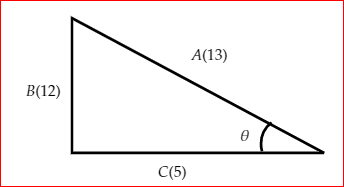
If \[A = B + C\] and the value of A, B, and C are 13, 12, and 5 respectively, then find the angle between A and C.
A.\[{\cos ^{ - 1}}\left( {\dfrac{5}{{13}}} \right)\]
B. \[{\cos ^{ - 1}}\left( {\dfrac{{13}}{{12}}} \right)\]
C. \[\dfrac{\pi }{2}\]
D. \[{\sin ^{ - 1}}\left( {\dfrac{5}{{12}}} \right)\]
Answer
216k+ views
Hints First we will apply the Pythagorean theorem to check whether the given triangle is a right-angle triangle or not. Then decide which are the legs and hypotenuse of the triangle. Then find the angle between B and C using the trigonometry ratios.
Formula used
The Pythagoras theorem for right angle is,
\[{a^2} + {b^2} = {c^2}\], where a is the base, b is the height, and c is the hypotenuse.
Also,
\[\cos \theta = \dfrac{p}{q}\], where p is the base and q is the hypotenuse.
Complete step by step solution
The given lengths of the sides are 13, 12, and 5.
Now,
\[{12^2} + {5^2}\]
\[ = 144 + 25\]
\[ = 169\]
\[ = {13^2}\]
Therefore, according to Pythagoras' theorem, the given triangle is right-angled.
The diagram of the given triangle is,

Use the formula \[\cos \theta = \dfrac{p}{q}\] , where p is the base and q is the hypotenuse to obtain the required result.
Therefore,
\[\cos \theta = \dfrac{5}{{13}}\]
\[\theta = {\cos ^{ - 1}}\left( {\dfrac{5}{{13}}} \right)\] .
The correct option is A.
Note Students often used cosine formula \[{A^2} = {B^2} + {C^2} + 2BC\cos \phi \] to obtain the angle between B and C and \[\theta\]. By using the cosine formula we cannot able find the angle between B and C. Because the cosine formula is applicable to an oblique triangle. Thus we will use trigonometry ratios to find the angle between them.
Formula used
The Pythagoras theorem for right angle is,
\[{a^2} + {b^2} = {c^2}\], where a is the base, b is the height, and c is the hypotenuse.
Also,
\[\cos \theta = \dfrac{p}{q}\], where p is the base and q is the hypotenuse.
Complete step by step solution
The given lengths of the sides are 13, 12, and 5.
Now,
\[{12^2} + {5^2}\]
\[ = 144 + 25\]
\[ = 169\]
\[ = {13^2}\]
Therefore, according to Pythagoras' theorem, the given triangle is right-angled.
The diagram of the given triangle is,

Use the formula \[\cos \theta = \dfrac{p}{q}\] , where p is the base and q is the hypotenuse to obtain the required result.
Therefore,
\[\cos \theta = \dfrac{5}{{13}}\]
\[\theta = {\cos ^{ - 1}}\left( {\dfrac{5}{{13}}} \right)\] .
The correct option is A.
Note Students often used cosine formula \[{A^2} = {B^2} + {C^2} + 2BC\cos \phi \] to obtain the angle between B and C and \[\theta\]. By using the cosine formula we cannot able find the angle between B and C. Because the cosine formula is applicable to an oblique triangle. Thus we will use trigonometry ratios to find the angle between them.
Recently Updated Pages
Alpha, Beta, and Gamma Decay Explained

Alpha Particle Scattering and Rutherford Model Explained

Angular Momentum of a Rotating Body: Definition & Formula

Apparent Frequency Explained: Formula, Uses & Examples

Applications of Echo in Daily Life and Science

Average and RMS Value Explained: Formulas & Examples

Trending doubts
JEE Main 2026: Application Form Open, Exam Dates, Syllabus, Eligibility & Question Papers

JEE Main Correction Window 2026 Session 1 Dates Announced - Edit Form Details, Dates and Link

Derivation of Equation of Trajectory Explained for Students

Hybridisation in Chemistry – Concept, Types & Applications

Understanding the Angle of Deviation in a Prism

Understanding Collisions: Types and Examples for Students

Other Pages
JEE Advanced Marks vs Ranks 2025: Understanding Category-wise Qualifying Marks and Previous Year Cut-offs

How to Convert a Galvanometer into an Ammeter or Voltmeter

Atomic Structure: Definition, Models, and Examples

Ideal and Non-Ideal Solutions Explained for Class 12 Chemistry

Degree of Dissociation: Meaning, Formula, Calculation & Uses

Understanding Electromagnetic Waves and Their Importance




